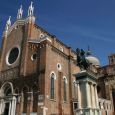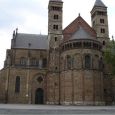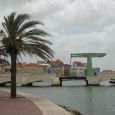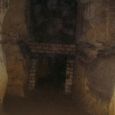Maastricht
Advertisement
By Airplane
Maastricht-Aachen Airport and Liege Airport receive low-cost flights, coming from many European countries and even from other continents.
By Train
Like all the major Dutch cities, Maastricht has excellent train connections. There are regular trains (including highspeed trains) coming from France, Belgium and Germany. Maastricht Centraal (Central Station) is situated nearby the City Centre.
By Bus
Busses coming from France, Belgium or Germany stop in Maastricht. You can travel cheap to Maastricht from anywhere in European Union with Eurolines, a low-cost european bus service. Inside the city, public transportation is very well organized by Stadsbus Maastricht. You can reach every corner of the city by urban buses.
St Servaaskerk
St Servaaskerk (R.C.), a Romanesque cruciform basilica, is the oldest church in the Netherlands, originally built in the sixth century over the grave of St Servatius, first bishop of Maastricht. The oldest part of the present church dates from the year 1000. The aisled nave was built first, followed by the transepts, the choir and new crypts. The porch at the west end is thought to be Carolingian. The west crypt and the transepts date from the early 11th century, the new east crypt under the crossing, the east choir and the towers over the choir from 1171. Around 1087 St Servaaskerk was given the status of an imperial church and became the seat of the imperial chancellery. An imperial throne was set up in the west choir as the emblem of secular power.
Wilhelminabrug
The Wilhelminabrug (1930-32; fine views of town) leads directly to the spacious Markt. The seven-arched St Servaasbrug was originally built in the 13th century, and also offers a good view of the town. On the bridge can be seen a modern statue of St Servaas (Servatius). Near the bridge a semicircular structure erected in 1984, marks the spot where the Romans built the first bridge over the river.
Dominican Church
The stone-built Dominican church in Dominicanerplein dates from the 13th century. There are remains of wall paintings of 1337 and 1619 on the vaulting. Most of the Dominican friary to which the church belonged has been demolished.
St Pietersberg Caves
To the south of Maastricht are the St Pietersberg Caves, a widely ramified system of tunnels and passages, formed over many centuries by the quarrying of the local marlstone, which provided shelter for the inhabitants during the town's many sieges. Originally there were some 20,000 passages with a total length of 200km/125mi. During the Second World War some of the passages were enlarged, a well was dug and storerooms, a bakery and even a chapel were constructed, providing accommodation in which most of the town's population could take refuge and live for a considerable period.
Since the rocks were formed on the bottom of an inland sea large numbers of fossils can be seen in the walls of the caves. The constant low temperature in the caves, shut off as they are from any strong inflow of air, provides ideal conditions for mushroom growing. There are regular conducted tours of the caves.
April - August





